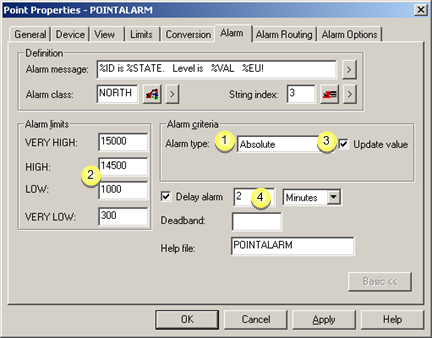Absolute alarms are used to detect when the value of a point is too high or too low.
Following is configuration for absolute alarms.

|
Alarm type |
|
|
Alarm limits |
|
|
Update value |
|
|
Delay alarm |
|
Alarm type |
Select Absolute.
|
Alarm limits |
Enter at least one alarm limit.
Entries can include 4 limits: very high, high, low and very low.
|
An alarm is generated when the: |
Point's value transitions from one Alarm State to another. |
![]() Note: Actual Alarm limits field names are determined by the
selected string index.
Note: Actual Alarm limits field names are determined by the
selected string index.
Each time the point's value is updated, its current value is compared with the alarm values.
|
Limit |
Description |
|
Too Full |
Point value ³ Alarm High value. |
|
Almost Full |
Alarm High value > Point value ³ Warning High value. |
|
Almost Empty |
Warning Low value ³ Point value > Alarm Low value. |
|
Empty |
Point value £ Alarm Low value. |
The point is in a Normal state when the value is less than the Warning High value and greater than the Warning Low value.
|
Update value |
(Optional) If %VAL is in the Alarm message:
|
Check |
Updates the value in the alarm message during runtime, when the value changes. |
|
Clear |
Does not update the value in the alarm message during runtime, when the value changes. |
|
Delay alarm |
(Optional) Delays the display of the alarm on Alarm Viewers and other Alarm Management Interested Processes unless the point remains in an alarm state for the configured interval.
|
When an alarm condition is |
The Point Manager sends the information: |
||
|
No Alarm delay is configured |
Immediately to the Alarm Manager and all other Point Management Interested Processes such as CimView and the Event Manager. |
||
|
An Alarm delay is configured |
After the delay time generates the Alarm Delay. This means that Alarm Delay applies to all the Point Management Interested Processes such as CimView, Point Control Panel and the Event Manager, the Alarm Viewer and other Alarm Management Interested Processes, such as the Alarm Printer, that are serviced by the Alarm Manager. |
||
|
Check box |
Check to display the length and interval fields. |
||
|
Length |
Length of selected interval time to delay the display |
||
|
Interval |
Options are:
|
||
|
Important: The minimum interval is 1 second. |
|||
|
|
|||
|
|
|
|
|
|
Step 3.2.2. Select alarm criteria. |